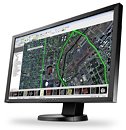Thursday, August 29th 2013
EIZO Releases DuraVision FDF2405W Monitor with 240 Hz Refresh Rate
EIZO Corporation today announced the DuraVision FDF2405W, a 23.5-inch color LCD monitor for displaying satellite images. The DuraVision FDF2405W reduces image lag with its 240 Hz blur reduction function. The monitor converts 120 Hz input signals to 240 Hz, doubling the number of frames for sharper, highly visible images with reduced motion blur that is caused by frame changes. This greatly contributes to eliminating eye fatigue that occurs when viewing scrolling or moving images.
The DuraVision FDF2405W also comes equipped with EIZO's patented drift correction circuit that stabilizes the screen brightness level within minutes after startup or from returning from power save mode. In addition, EIZO's Digital Uniformity Equalizer (DUE) technology improves picture quality by counteracting fluctuations in brightness and chromaticity across the screen.A 3D LUT is used to adjust colors individually on an RGB cubic table. This improves the monitor's additive color mixture, a key factor in its ability to display neutral gray tones displayed in satellite images.
The DuraVision FDF2405W supports EPD (Equal Probability of Detection) gamma, defined by the United States National Geospatial Intelligence Agency. With it, the monitor displays subtle variations in tones more clearly in undefined areas of satellite images and aerial photos. The EPD preset mode ensures that each gradient step between black and white can be detected and defines objects and details in images that would otherwise be difficult to see.
The 3-pin mini-DIN connector equipped in the DuraVision FDF2405W generates a sync signal with 120 Hz input so the monitor can display 3D images using an active shutter 3D system. The FDF2405W has a wide viewing angle of 176° so users experience minimal color shift when viewing the monitor from an angle. In addition, the high contrast ratio of 5000:1 combined with the maximum brightness of 350 cd/m² maintains excellent screen visibility where details are essential. The non-glare panel also dissipates reflective light for high readability, even in bright ambient conditions.
Additional Features
The DuraVision FDF2405W also comes equipped with EIZO's patented drift correction circuit that stabilizes the screen brightness level within minutes after startup or from returning from power save mode. In addition, EIZO's Digital Uniformity Equalizer (DUE) technology improves picture quality by counteracting fluctuations in brightness and chromaticity across the screen.A 3D LUT is used to adjust colors individually on an RGB cubic table. This improves the monitor's additive color mixture, a key factor in its ability to display neutral gray tones displayed in satellite images.
The DuraVision FDF2405W supports EPD (Equal Probability of Detection) gamma, defined by the United States National Geospatial Intelligence Agency. With it, the monitor displays subtle variations in tones more clearly in undefined areas of satellite images and aerial photos. The EPD preset mode ensures that each gradient step between black and white can be detected and defines objects and details in images that would otherwise be difficult to see.
The 3-pin mini-DIN connector equipped in the DuraVision FDF2405W generates a sync signal with 120 Hz input so the monitor can display 3D images using an active shutter 3D system. The FDF2405W has a wide viewing angle of 176° so users experience minimal color shift when viewing the monitor from an angle. In addition, the high contrast ratio of 5000:1 combined with the maximum brightness of 350 cd/m² maintains excellent screen visibility where details are essential. The non-glare panel also dissipates reflective light for high readability, even in bright ambient conditions.
Additional Features
- Stand with wide height adjustment range, tilt, and swivel
- Portrait mode capability
- USB hub with one upstream and two downstream ports
- Quiet fanless operation
- Equipped with energy-saving LED backlight
- Backed by a 2-year, 24-hour continuous use warranty

15 Comments on EIZO Releases DuraVision FDF2405W Monitor with 240 Hz Refresh Rate
So there I was, very excited about this monitor, until I noticed the resolution data was absent. Why? Because Native Resolution = 1920 x 1080 ie TOTALLY RUBBISH FOR MAP WORK where higher resolutions are really needed.
BOO to Native Resolution 1920 x 1080. Let's start a worldwide boycott of 1920 x 1080 on PCs. TV OK. PC no.
anyway, affordable hardware capable displaying crysis 3 at 120fps wont be here for another 6 years..
/facepalm
It seems to me like getting the display to refresh at 240 Hz would be the hard part and getting hardware to push it to the display would be the easy part. Why only go half-way?
Well I guess since 1080p is FULL hd, it just can't get any fully.
So why mention it?
Also, I don't see how they can emulate 240Hz on 120Hz hardware without buffering (hence delaying) frames.
Maybe still fast enough it wont' be a problem? I could live with 120Hz anyway.
So main selling point is something it doesn't really do and no one really needs. Nice.
Shit, what have I just started?
It's unofficially possible but can be made, all those restrictions are artificial and can be avoided with toastyx driver patcher ;)
Eizo use LightBoost-style strobe backlight for 240Hz. No interpolation used.
Upon studying the Eizo FDF-2405W manual:
www.eizo.com/global/support/db/files/manuals/03V24694A1/Manual-EN.pdf
For Eizo’s upcoming monitor, there is good news on page 15:This means no interpolation is used, so no input lag from interpolation! The Eizo “240Hz” monitor achieves 240Hz via a two-pass refresh. One overdriven refresh in the dark, unseen by the human eye, followed by a single backlight strobe flash on a very clean 120Hz refresh. This should produce excellent LightBoost-style quality, reasonable input lag, and excellent VA colors. Although this model is targeted at GIS/mapping, this could potentially become an excellent casual-gaming 120Hz monitor with great color! An interesting question is the strobe flash length, as shorter strobe flahes results in less motion blur.